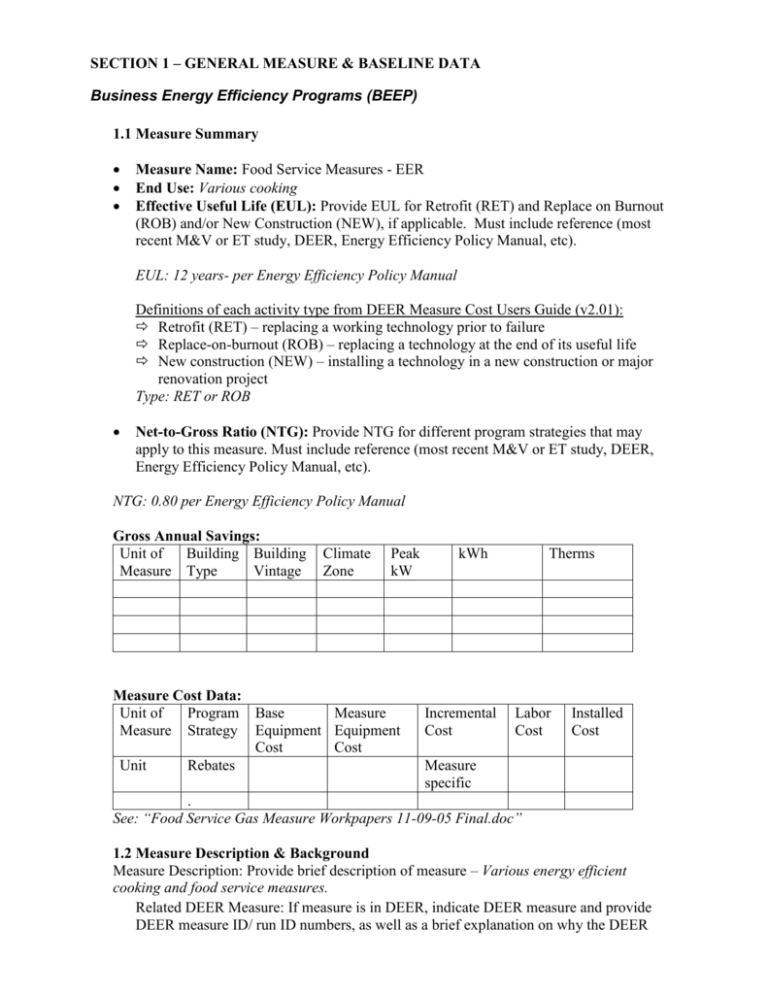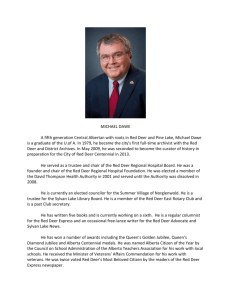SECTION 1 – GENERAL MEASURE & BASELINE DATA
advertisement

SECTION 1 – GENERAL MEASURE & BASELINE DATA Business Energy Efficiency Programs (BEEP) 1.1 Measure Summary Measure Name: Food Service Measures - EER End Use: Various cooking Effective Useful Life (EUL): Provide EUL for Retrofit (RET) and Replace on Burnout (ROB) and/or New Construction (NEW), if applicable. Must include reference (most recent M&V or ET study, DEER, Energy Efficiency Policy Manual, etc). EUL: 12 years- per Energy Efficiency Policy Manual Definitions of each activity type from DEER Measure Cost Users Guide (v2.01): Retrofit (RET) – replacing a working technology prior to failure Replace-on-burnout (ROB) – replacing a technology at the end of its useful life New construction (NEW) – installing a technology in a new construction or major renovation project Type: RET or ROB Net-to-Gross Ratio (NTG): Provide NTG for different program strategies that may apply to this measure. Must include reference (most recent M&V or ET study, DEER, Energy Efficiency Policy Manual, etc). NTG: 0.80 per Energy Efficiency Policy Manual Gross Annual Savings: Unit of Building Building Measure Type Vintage Climate Zone Peak kW Measure Cost Data: Unit of Program Base Measure Measure Strategy Equipment Equipment Cost Cost Unit Rebates kWh Incremental Cost Therms Labor Cost Installed Cost Measure specific . See: “Food Service Gas Measure Workpapers 11-09-05 Final.doc” 1.2 Measure Description & Background Measure Description: Provide brief description of measure – Various energy efficient cooking and food service measures. Related DEER Measure: If measure is in DEER, indicate DEER measure and provide DEER measure ID/ run ID numbers, as well as a brief explanation on why the DEER numbers are not applicable DEER does not currently include industrial/process new construction measures. Base Case for Savings Estimate (Existing and Above Code): Provide description of measure base case and cite any codes and standards requirement analysis as applicable. (Include applicable references in Section 4) – Baseline equipment is generally standard efficiency (e.g., non Energy Star rated). In some cases the equipment is older inefficient models. See: “Food Service Gas Measure Workpapers 11-09-05 Final.doc” 1.3 Load Shape Indicate applicable measure load shape(s) - Annual SECTION 2 – SAVINGS CALCULATION (ENERGY AND DEMAND) 2.1 Energy Savings Estimation Methodologies (Electric & Natural Gas) Describe energy savings estimation methodologies. Include explanation and sample calculation including assumptions for hours of operation, energy interactive effects, etc., as applicable and cite references. Calculation methodology must meet commonlyaccepted industry standards, such as ASHRAE standards, EM&V protocol, etc. See Section 1.2 above. 2.2 Peak Demand Reduction Estimation Methodologies (Electric) Describe peak demand reduction estimation methodologies. Include explanation and sample calculation including assumptions for coincident diversity factors, demand interactive effects, etc. as applicable and cite references. Calculation methodology must meet commonly-accepted industry standards, such as ASHRAE standards, EM&V protocol, etc. See Section 1.2 above. SECTION 3 – BASE CASE & MEASURE COSTS Provide description of base case and measure costs, and explanation of which cost is used for different program strategies. – See “Food Service Gas Measure Workpapers 11-09-05 Final.doc”. Definitions from DEER Measure Cost Users Guide (v2.01): Base equipment cost – the cost of the baseline efficiency technology Measure equipment cost – the cost of the energy-efficient technology Incremental cost – the difference between the measure equipment cost and the base equipment cost Labor cost – the installation cost of the measure including contractor overhead & profit Installed cost – the sum of the measure equipment cost and the labor cost 3.1 Base Case Costs Provide description of base case costs, including base equipment, installation labor, maintenance, etc. as applicable. 3.2 Measure Costs Provide description of measure case costs, including measure equipment, installation labor, maintenance, etc. as applicable. 3.3 Incremental Measure and Installed Costs Provide explanation of what costs (incremental measure and installed costs) are used for different program strategies. SECTION 4: REFERENCES AND CITATION Provide references and citations, such as: Related EM&V studies (Ex Post Data, etc.) Market potential & saturation (RASS, CEUS, etc.) Engineering/industry references SECTION 5 – APPENDICES A. B. C. D. Document Revision History, including revision approvals Tables Figures Lists





